Lemon Mousse in 60 Seconds
July 21st, 2009 | 54 Comments
Ok, ok. You have to have lemon curd on hand first.
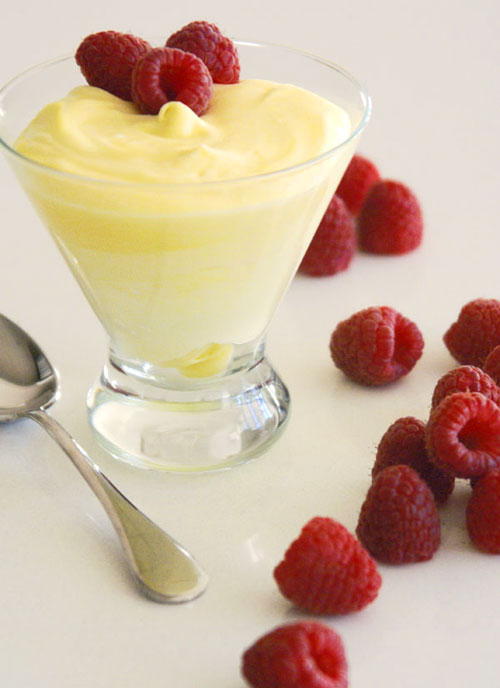
Ugh, lemon curd. Sounds like something you churn up in a barn. But despite its rather unpleasant sounding name, it is one of the most valuable recipes to have in your repertoire. Not only does it taste incredible, like a lemon exploded in not only your mouth but the immediate surrounding area, it’s as versatile as Johnny Depp. You can use it simply to top off a scone or as a dip for shortbread, slather some between cake layers (coconut or yellow cake work great), or pipe some in a tart shell and top with fruit for an insta-tart.
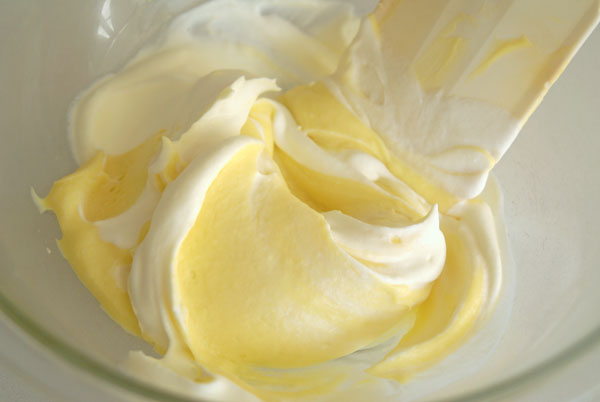
When I was a wee pastry assistant at my first restaurant job, the pastry chef (and the chef that I now consider my mentor) taught me how to make lemon curd. Because we always made large batches of everything, my setup consisted of a bowl the size of a satellite dish parked over a heavy-duty pot of boiling water. Dozens of eggs were cracked and cases of lemons were juiced into this monster basin. There I stood, full body hunched over this stew, whisking like my life depended on it. Whisking, whisking. Whisking the crap out of this mix. Blisters were forming on my hands from the giant strokes. The steam bubbling from beneath the bowl was starting to infiltrate every pore. Sweat dribbled down the sides of my face, into my jacket collar. Finally, coming close to my threshold for pain, I asked the chef, “How do I know when it’s done?” I waited expectantly for his wisdom. With a mischievous glint in his eye he smiled, and said “When the sweat starts pouring down the crack of your ass.”
I guess it was done.
Thankfully, this small batch couldn’t be easier and comes together in about 15 minutes. If curd alone isn’t good enough, take it to a whole ‘nother level. By simply folding in whipped cream, it transforms into a lemon mousse, one so light and velvety, it evaporates off the tongue before you even realize what’s happening. This dessert becomes the star of it’s own movie, carrying the whole production.
First, the Lemon Curd
makes about a pint
3 large eggs
3 large eggs yolks
1/2 cup sugar
zest of 1 lemon (strip the lemon of zest before you juice, or you’ll be desperately trying to scrape zest off lemon peels, like I’ve been caught doing)
1/2 cup lemon juice (if you want this to taste fresh and vibrant, not chemically and processed, you MUST squeeze your own lemons. Five or six lemons should do it. Taking the time is beyond worth it.)
pinch of salt
2 sticks (8 oz) unsalted butter, cut up into small pieces
1. Gather the goods. While you’re gathering, fill a medium pot with a couple of inches of water and bring to a boil. We’re going to improvise a double boiler.
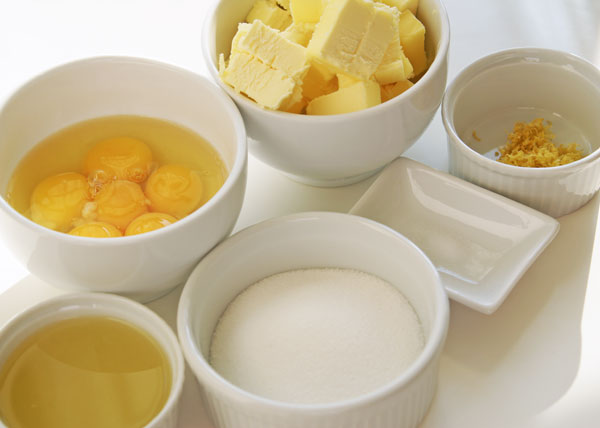
2. Plop the eggs, sugar, lemon zest, lemon juice and salt into a large bowl. Keep the butter chilled.
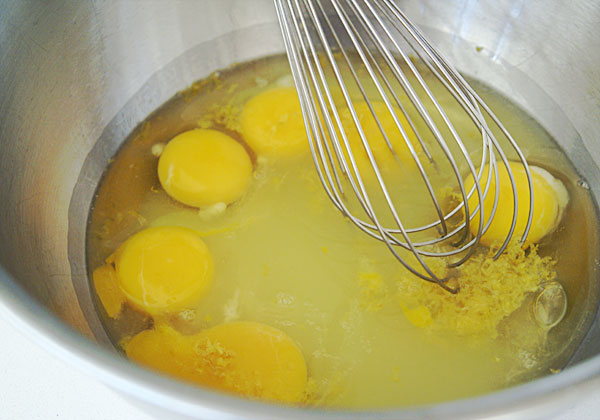
Whisk it up.
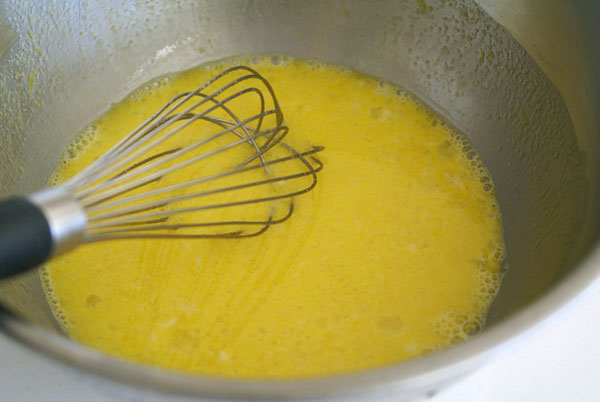
3. Set the bowl over the pot with boiling water. This is our faux double boiler.
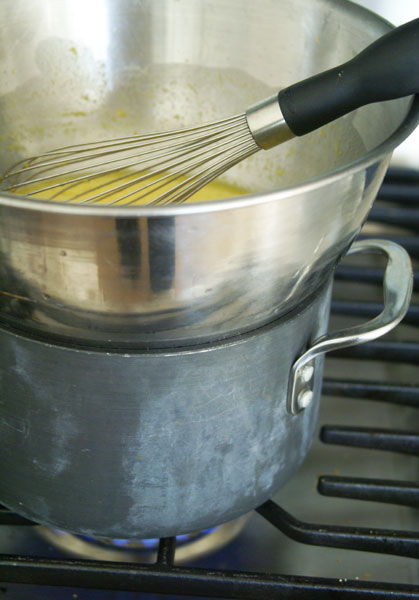
4. Now whisk like a hurricane, fast and furious. You must whisk the entire time the bowl is over the water. Keep the mixture moving, so the eggs don’t get a chance to scramble. After a few minutes (five?) it starts to get frothy. (If necessary, hold the bowl still by gripping the edge with a kitchen towel.)
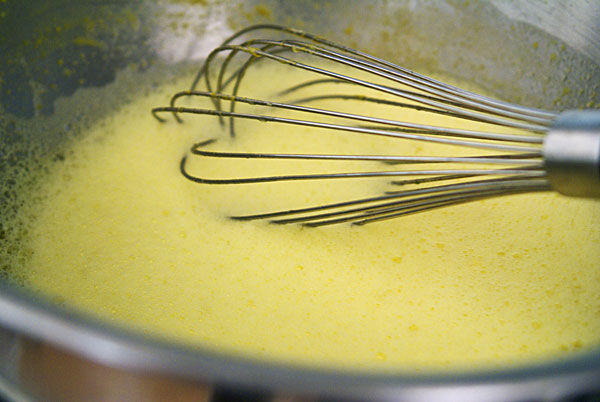
Keep on whiskin’. After a few more minutes (five more?), it transforms into something creamy.
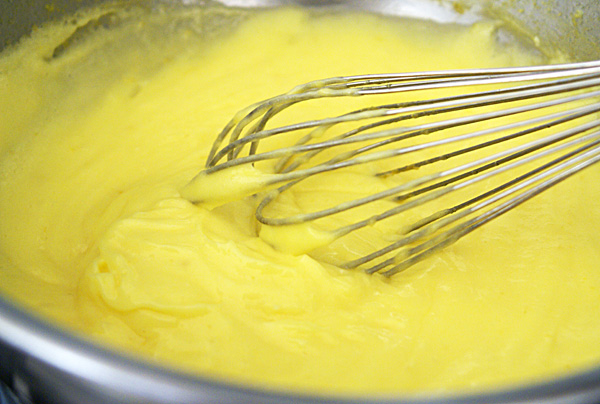
Whisk for another minute just to thicken it up.
5. Take the bowl off the heat. Feed it a handful of butter and whisk it in. The residual heat of the curd will melt it.
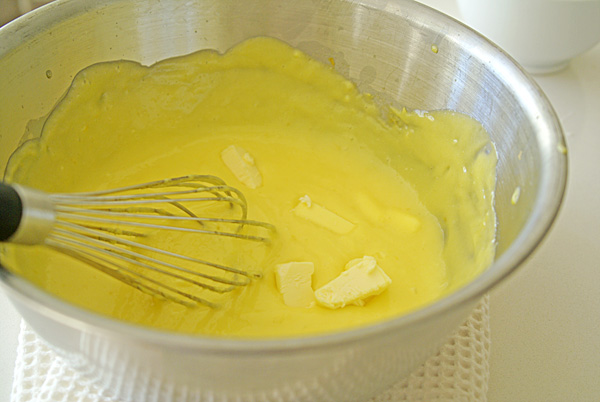
Keep adding handfuls of butter until it’s all in and fully incorporated. If you still see any little lumps, return to the double boiler for a brief minute, until they disappear, but this is rarely necessary.
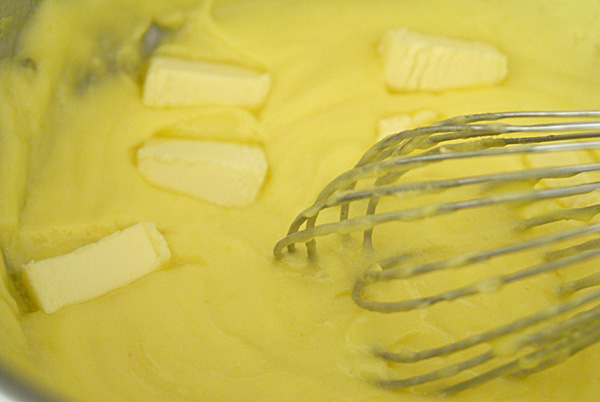
6. Push the curd though a fine mesh sieve to remove the stray bits of scrambled egg that didn’t cooperate.
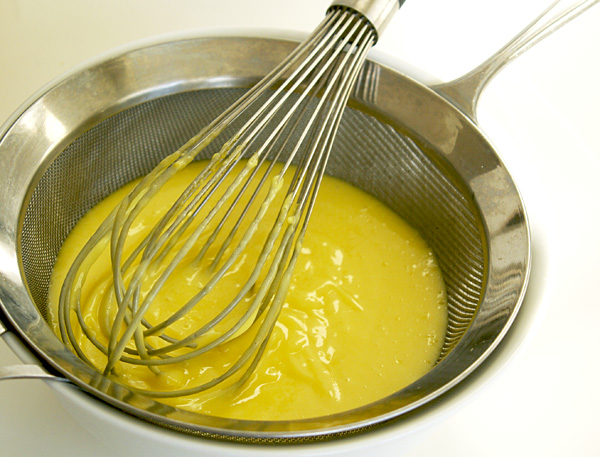
7. Voila. Strained curd.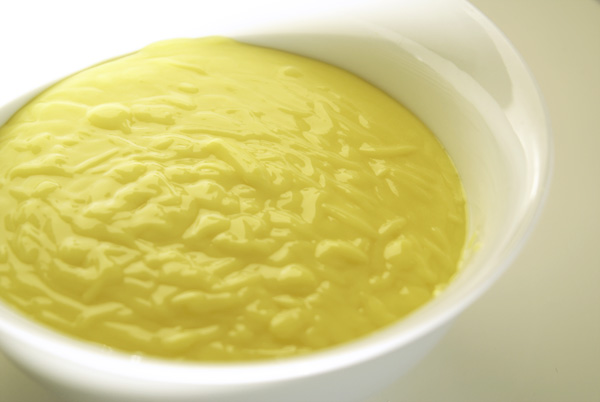
You can enjoy it warm or…
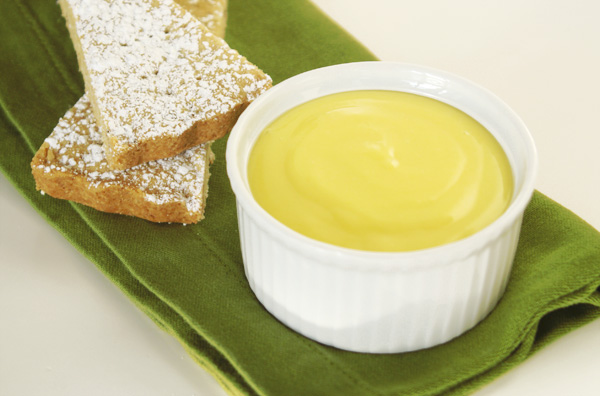
…put a piece of plastic wrap directly on its surface to prevent a skin from forming and refrigerate. Once it’s completely cold, wrap the whole container tightly and store. (The curd will firm up considerably as it cools. Give it a good stir to loosen it up again before using.) You can store it in the fridge for up to 5 days or freeze for up to a month. To defrost, let the container thaw in the fridge overnight.
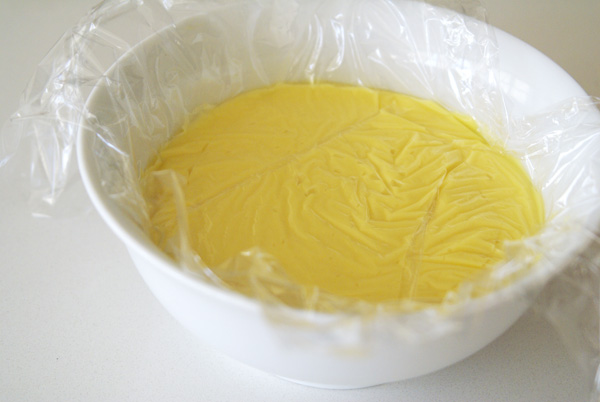
Second, the Lemon Mousse
Talk about being able to whip up a dessert on the fly! This makes 6-8 servings, depending on how much you can put away in one sitting. In my house, sometimes it’s even less than 6.
1 cup heavy cream
1/4 cup sugar
1 1/2 cups lemon curd (recipe above, in case you missed it)
1. The add-ons.
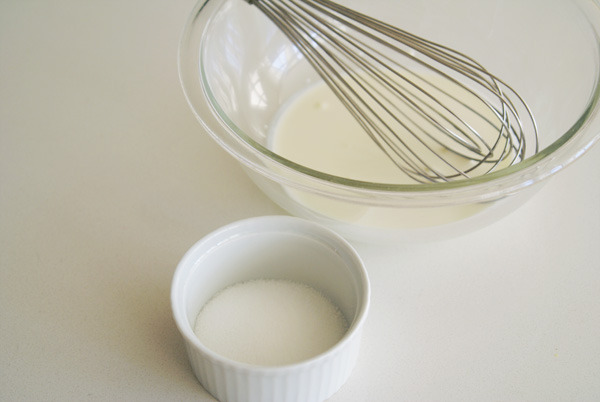
2. Throw the sugar in with the heavy cream and whisk your buns off. We want it to reach “soft peak” stage, which means you can see streaks in the cream, but the peaks are not stiff and defined. The peaks should be sad and droopy.
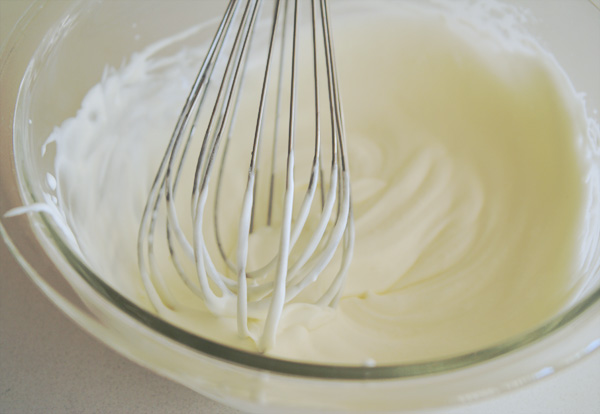
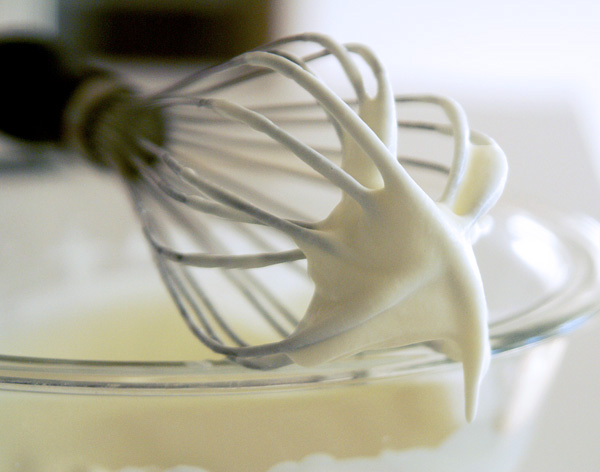
3. Because we whipped air into the cream and made it light and delicate, and because the curd is heavy and dense, we will fold the cream into the curd gradually, so we don’t completely deflate the cream. Scoop a third of the whipped cream into the bowl with the curd. You can eyeball this. It doesn’t have to be exact.
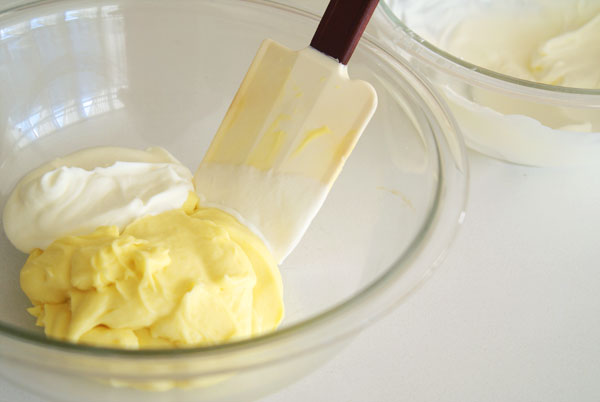
Gently fold it in.

Here it is folded. You can see it looks lighter already.
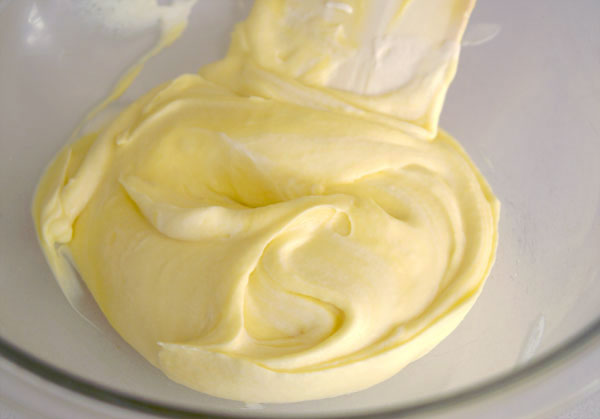
4. Scrape in the rest of the heavy cream and fold it in.
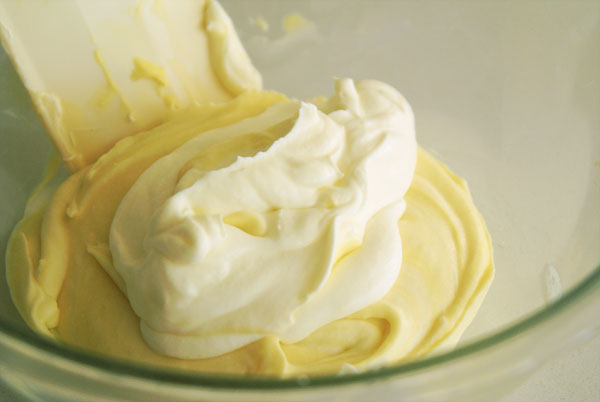
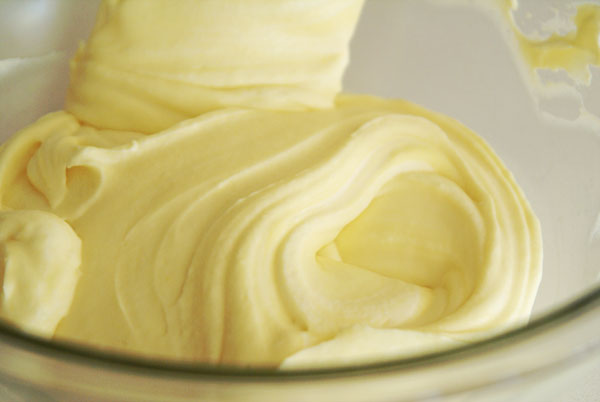
5. Spoon into pretty wares. This can be served right away, or refrigerated for up to 8 hours.
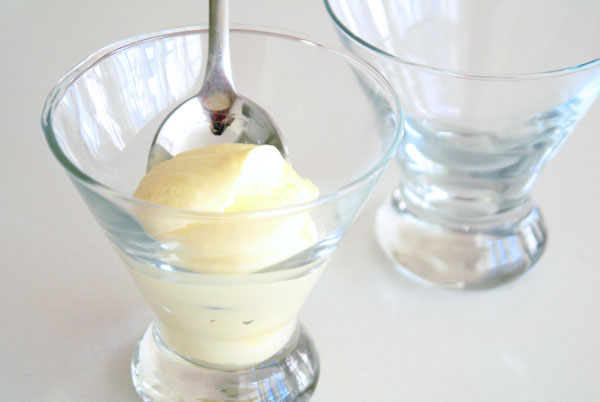
Enjoy!
First, the Lemon Curd
makes about a pint
3 large eggs
3 large eggs yolks
1/2 cup sugar
zest of 1 lemon (strip the lemon of zest before you juice, or you’ll be desperately trying to scrape zest off lemon peels, like I’ve been caught doing)
1/2 cup lemon juice (if you want this to taste fresh and vibrant, not chemically and processed, you MUST squeeze your own lemons. Five or six lemons should do it. Taking the time is beyond worth it.)
pinch of salt
2 sticks (8 oz) unsalted butter, cut up into small pieces
First, make the curd:
1. First gather all your ingredients.
2. Fill a medium pot with a couple of inches of water and bring to a boil. We’re going to improvise a double boiler.
3. Pour the eggs, sugar, lemon zest, lemon juice and salt into a large bowl. (Keep the butter chilled.) Whisk it up.
4. Set the bowl over the pot with boiling water. This is our faux double boiler.
5. Now whisk like a hurricane, fast and furious. You must whisk the entire time the bowl is over the water. Keep the mixture moving, so the eggs don’t get a chance to scramble. After a few minutes (five?) it starts to get frothy. (If necessary, hold the bowl still by gripping the edge with a kitchen towel.)
6. Keep on whiskin’. After a few more minutes (five more?), it transforms into something creamy. Whisk for another minute just to thicken it up.
7. Take the bowl off the heat. Feed it a handful of butter and whisk it in. The residual heat of the curd will melt it. Keep adding handfuls of butter until it’s all in and fully incorporated. If you still see any little lumps, return to the double boiler for a brief minute, until they disappears, but this is rarely necessary.
8. Push the curd though a fine mesh sieve to remove the stray bits of scrambled egg that didn’t cooperate.
9. Put a piece of plastic wrap directly on its surface to prevent a skin from forming and refrigerate. Once it’s completely cold, wrap the whole container tightly and store. (The curd will firm up considerably as it cools. Give it a good stir to loosen it up again before using.) You can store it in the fridge for up to 5 days or freeze for up to a month. To defrost, let the container thaw in the fridge overnight.
Perhaps make it into mousse?
1 cup heavy cream
1/4 cup sugar
1 1/2 cups lemon curd (recipe above, in case you missed it)
1. In a medium bowl, whisk together the sugar and heavy cream to soft peak stage.
2. Because we whipped air into the cream and made it light and delicate, and because the curd is heavy and dense, we will fold the cream into the curd gradually, so we don’t completely deflate the cream. Scoop a third of the whipped cream into the bowl with the curd. You can eyeball this. It doesn’t have to be exact. Gently fold it in.
3. Scrape in the rest of the heavy cream and fold it in.
4. Spoon into pretty wares. This can be served right away, or refrigerated for up to 8 hours.
54 Responses to “Lemon Mousse in 60 Seconds”
Post a Comment
Your E-Mail will be kept private. * = required fields.







The first time I made lemon curd, it curdles… Now, if I followed your detailled instruction I shoud get it right. I love mousse also, I never tried lemon mousse, seems a great idea.
Oh, your photos are so lovely. I had a wistful look on my face all through the process hehe. Have you ever heard of the recipe for microwave lemon curd? I’ve yet to try it, but it looks interesting. Your mousse looks so refreshing.
That mousse sounds delicious, and easy to make!
This is the most beautiful photo tutorial I’ve ever seen! Simply gorgeous!
This looks fantastic! I have a TON of lemon curd I made at Christmas, intending to give as gifts… but ended up keeping for myself (ah! so selfish. Oh, but so tasty). I’m really excited about using this recipe!
I’m hosting a bridesmaid luncheon and I plan to pipe the mousse into individual tart shells, top with
a dollop of whipped cream and a raspberry or two. Yum!
Ah… I think I found my first repertoire expansion. The lemon mousse sounds absolutely awesome. Great job on the picture tutorials, Irina.
P.S.
A) The writer in me just loves this: “… like a lemon exploded in not only your mouth but the immediate surrounding area…” 🙂
B) (In reference to your previous entry) I’m gratified to hear I wasn’t the only one in our class who read things like Gourmet and used their parents as guinea pigs for things that didn’t quite come out resembling the picture. 😉
Thanks for sharing such amazing recipe. Will definetely give a try of this recipe. Thanks
lemon curd is easy to make provided you don’t turn the heat up too high and make scrambled eggs. Microwave? yes, do it in 30 second bursts. cook, whisk, cook, whisk. its ready really fast.
and the other thing about lemon curd is that it costs from $4 to $7 for a wee tiny jar of the stuff and you can make buckets of it at home for that and 15 minutes.
The pix are gorgeous. I’m going to make some lemon curd today. Did you remember about a pie? graham cracker crust. thin layer of dark chocolate. layer of lemon curd. whipped cream? what could be easier? it can all be done in the microwave. you melt chocolate the same way you heat the curd. 30 second increments.
You inspire me Irina. what’s next?
First of all, this looks fantastic. Great photos!
And you deliver a fine punch line! Love the story about your chef days. : )
Hi, Love the fact that u added photos for basically each step of the recipe. Do you know of any easy recipes for croissants?
Hi Linda–Thanks! All the recipes I know for croissants are pretty traditional. I can’t think of any ways to cut corners, since you still need the butter steps and the folding over steps to make it flaky. I don’t think they’re hard to make, they just require a little attention every now and then, over a period of time. I’ll post the method soon. Hopefully the photos will make it look doable.
Love your recipe. The photos are great help. Really liked idea of being able to freeze it. I am entering 22 things at California State fair in 2 days of showing. Do ahead things help!
The mousse looks delicious!!! As does the lemon curd. Thanks for all the amazing step-by-step pictures! They help soo much 🙂
NEVER AGAIN!!
Push the curd though a fine mesh sieve to remove the stray bits of scrambled egg that didn’t cooperate
A foolproof method makes the smoothest lemon curd
BY Mary Jane
Lemon curd is easy to prepare, except for one pesky problem: it sometimes winds up with bits of cooked and curdled egg. This problem is especially common in curds that use whole eggs as well as egg yolks. Because the eggs whites cook at a lower temperature, they’re more prone to coagulation. These cooked bits don’t ruin the flavor of the curd, but a smooth texture will require careful straining, and quite a bit of the mixture can get lost in the process. It’s also rather alarming, especially for the uninitiated, to see those white lumps form during cooking.
Instead of simply combining the ingredients in the pan on the stove as most lemon curd recipes call for, Mary Jane mixed the ingredients as if she were making a cake. She creamed the butter and sugar until fluffy, beat in the eggs slowly, and only then did she add the lemon juice. The method works every time: the curd thickens properly, becomes satiny-smooth, and there’s not one drop of cooked egg to strain.
Why does this method for making lemon curd work so well?
Successful lemon curd is the result of battling forces that encourage and discourage the eggs to coagulate. You want the eggs to thicken — but not too much, and not too soon.
Heat encourages the proteins in eggs to bond, as does the addition of acidic ingredients. Diluting the eggs raises the temperature at which coagulation begins, simply because it keeps the protein molecules in the eggs physically farther apart. According to food scientist Harold McGee, one tablespoon of sugar is enough to surround each protein molecule in a large egg with a screen of several thousand sucrose molecules.
But many recipes for lemon curd begin by beating the eggs with the sugar. What sets this one apart is the early addition of the fat. “What we should have here is that the butter is coating the protein molecules pretty well,” says food scientist and Fine Cooking contributing Editor Shirley O. Corriher. The coating of fat helps protect the eggs from the acid in the lemon juice.
The electric mixer gives you further insurance, adds Corriher. The vigorous beating denatures the proteins in the eggs, partially “cooking” or tempering them so that they won’t curdle as easily when heated.
Constance — Very interesting. I’ll try this method next time I make curd.
UPDATE: I checked Shirley O’Corriher’s book, Bakewise, and she makes lemon curd by whisking ALL the ingredients together over a double boiler, and still strains the mix. She says she ends up with about a teaspoon of curdled eggs, which is, at most, what I might get with the recipe above, if anything at all. Her recipe has 4x as much sugar as the one I use, though I don’t know if that’s good or bad, science-wise. Her own book says that sugar keeps eggs from setting. It does sound like the curd would be outrageously sweet.
Will this recipe work if I use it as one of the layers for a layer cake?
Rachael — Yes, it should work well. I’ve used it as a cake layer before.
I made the curd and the mousse tonight & it was great!
I was intimidated by the curd, but it came together quicker than I expected.
Heck, I had enough lemon juice that I tried a different lemon curd recipe; although it was easier, it took quite a bit more time and dirtied a lot more dishes!
I made the mousse with your curd recipe & my wife and I enjoyed it quite a bit. Thanks for the recipe!
I may tackle your tart next…
Dan—Always glad to hear of a success. If you have the curd mastered, the tart’s a breeze.
Found you via Baking Bites post about your yummy Vanilla & White Chocolate Raspberry Tart. Love your site and recipes. I had a question on this one – can I use a hand mixer when mixing the Lemon Curd on the double broiler? Your pictures show a whisk and I have a mild nerve issue in my hand/arm that makes it mildly painful to whisk something for the time called for in your recipe.
Thanks for any help/direction you can provide.
Have a great new year!
Carey — Yes, feel free to use a hand mixer, keep it on medium low speed and be sure to drag it around the bowl to keep everything moving. Happy new year to you!
I just made this lemon curd for the first time in my life and it turned out PERFECT! My husband said he thinks it’s the best thing he’s ever eaten in his life. He wants to hook it up to an IV and have it injected directly into his bloodstream, he loves it that much. I used it as a filling for my first buttercream cake which didn’t turn out looking quite as perfect, but it tasted amazing. I’m going to tackle some fruit tartlets tomorrow with the leftovers. Thanks so much for these detailed instructions!
Gina — Another great day of baking! Thank you for making the curd. I could eat buckets of it, too, so I know what your husband means. And the leftovers will be perfect in fruit tarts.
By the way, your web designs are beautiful.
Hi, I’m going to try your lemon curd and was wondering can I use this recipe (with the whipped cream) as a cake filling and than cover it with fondant?
Thanks!!!
Doris
Hi Doris — I think you can, though the curd with whipped cream is on the soft side, and may ooze out the sides when you top it with another cake layer. So I’d keep the mousse layer thin, or hollow out the cake layers a little to fill with lemon mousse. Good luck!
Thankyou very very much for your reply! I tried it and it’s greaaaat! I really want to use it but i’m a bit concerned. Do you think If i keep it out of the fridge for say a day and a half, just the time for me to cover the cake with fondant and deliver it, do u think it will hold its consistency? Cause I heard you can’t put fondant in the fridge. Thanks for your help, I’m panicking cause i need the cake ready for sunday.
Thanks so much !
Doris,
Ah, that’s another dilemma, and you’re right fondant doesn’t do well in the fridge. Anything with whipped cream in it doesn’t hold at room temperature for that long. If it was my cake, I’d do one of three things:
1. Skip the whipped cream and spread just the curd over the layers
2. Rethink my filling. Maybe a lemon buttercream?
OR, (and this is the riskiest)
3. I’d add gelatin to the mousse recipe. (Before you start making the curd, dissolve one envelope of gelatin over 1/4 cup of water. Right after you take the curd off the heat, and before you add the butter, whisk in the gelatin until fully dissolved and then add in the butter pieces. Strain it. Do not refrigerate the curd. Take out the amount of curd you need. Whip the cream right then and fold it in. Then pour it immediately onto the cake layers and refrigerate. The gelatin will set up the mousse in the cake.)
It should hold a lot better at room temperature that way, but still, a day and half is a long time to keep dairy out of the fridge and the filling will probably suffer anyway. If possible, keep the cake in a cool area.
I made this curd today with lemons I got from a neighbour’s tree and it came out perfect, I could just eat it all straight from the bowl!!
I’ll try the mousse tomorrow maybe with some chocolate shavings on top.
Thanks for all the details , you helped me a lot!
Missing new entries… best wishes! =)
Sil
Pipe the mousse into scooped out lemon shells. Cut the bottom of the lemon so that is sits flat but do not cut the bottom so that it makes a hole. Wonderful look and unique way to serve this wonderful dessert.
I made this for the first time last night and it turned out awesome!!!!!! My family loved it. Plus I got to spend some quality time with my husband,he whisked like a hurricane! After about two minutes my are was stinging. I had him take over so we would not have scrambled eggs. He too whisked like a hurricane.lol I am going to use an electric mixer next time and save our arms;) Thank you for this awesome recipe and the show and tell with the pictures.-Kristie
Hi,
I absolutely love your lemon curd recipe! it turns out great every time. I was wondering though, have you tried making lime curd? I might just give it a go, but maybe you just happen to know the replacement ratio of limes to lemons, as limes are a bit tarter, aren’t they? thanks!
Thank you for the pictures and detailed instructions. This is wonderful. How do you think it would work with less butter. It already tasted delicious before i added it. Could you leave some out–especially if you are going to add whipped cream for mousse?
Pam — Yes, you can leave out some of the butter. I’d go with half. One of the things the butter helps with is the firmness of the curd when it chills, but you should be fine if you’re making mousse.
I am looking forward to making your lemon mousse. I plan on making homemade chocolate shells, then will pipe the mousse into the shells! Can’t wait!
i tried to make the curd, it’s successful and the taste is very good, i’ll make the lemon berry tart tomorrow, will post the outcome.
irina, may i use electric mixer for the curd whisking process? tkx!
Emelly — I’m so glad the curd worked out for you. And yes, you can use the electric mixer.
My fiance doesn’t get too excited about food…usually his response is “yeah, pretty good”. I made the curd this afternoon and gave him some while it was still warm…his response was “that is fantastic.” I call that a success. Thanks 🙂
OMG this recipe is to die for. Ur instructions were simple and the photos are gorgeous. I filled vanilla cupcakes with this divine Lemon mousse for an order I had. They all loved it. Thank u so much for sharing this recipe. Xoxo
I made this and it was DELISH!!! So creamy and fluffy. Thank you for the recipe! I also pinned you on pinterest.
I just made the curd its delicious, ill be making the mousse later for a dinner party I have, thanks!
We got exactly two Meyer lemons off our 3-year old tree this year. Supplemented with a few organic lemons from the market, guess what I’m making for dessert tonight? Thanks!
I like your recipe I need it for french homework
I just finished making the lemon mousse tonight, starting from the lemon curd recipe. It simply tastes wonderful. Total success! Thank you!!
i suck at it 🙁 i try to made it for the first time and this is my first time baking a pie and the lemon curd turns out to be much more to a liquid instead creamy D: but I’m still gonna keep on trying it 🙂 btw awesome photos and amazing recipe !
I made it the first time this morning and it was a success!!! It’s so yummy i feel like im in heaven!!!! Thanks so much for the detail recipe and the photos help alot!
Viv — That’s so sweet of you to come back and let me know! Glad you enjoyed the recipe.
Great recipe!
Does the mousse require gelatin ? It needs to be kept for a week. Pls adv
Ritu — If you intend to keep it for a week, I would certainly add a little gelatin, but i will propose that it won’t taste as bright and fresh after 3 or 4 days.
Thanks for your prompt reply. Once again,the recipe is just superb!